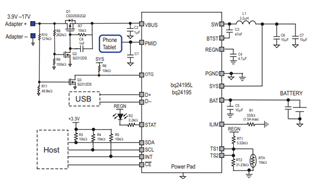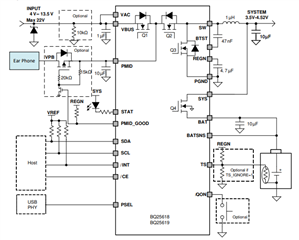Other Parts Discussed in Thread: BQ24195, BQ25618
Hello,
I'm using the BQ24295 ic on an embedded system where I need 5v boost for screen and leds (connected to PMID), and 3.3v for MCU (nRF52840). 3.3v is provided from an LDO connected to the Battery. I have a power switch to turn off the 3.3v LDO off when I don't use the board, so the MCU stops emitting radio packets and also in order to have no current drawn from the battery when not in use.
The power switch pulls down the EN signal of the LDO and is also connected to the OTG pin of the BQ24295, because I want the 5v coming on the PMID to be also cut off when I turn off the board.
However, when VBUS is disconnected and when OTG is pulled low the voltage on the PMID pin does not drop to 0v, it drops to SYS voltage, which is understandable as Q2 body diode connects PMID to SYS. And when I disable BATFET by I2C PMID goes to 0v.
Is there any simple hardware solution to avoid this and to have PMID completely disabled when OTG is pulled low ? If not is there another similar IC that could do this ?




